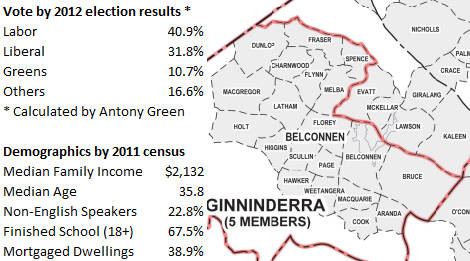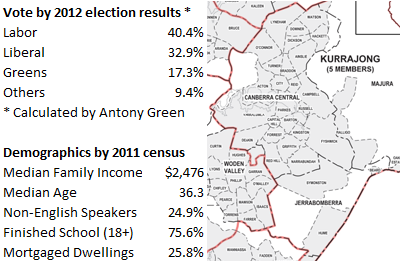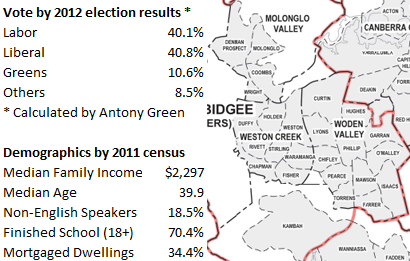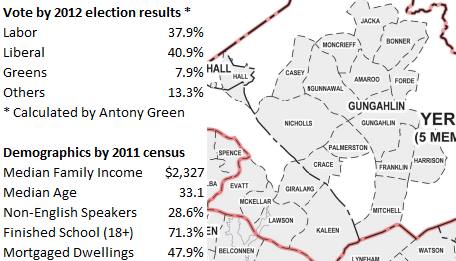Overview
The Australian Capital Territory election on Saturday, October 15 will be the ninth held since the first under self-government in 1989, and the first under the new system of five five-member districts, through which the size of the Legislative Assembly will increase from 17 seats to 25. The electoral system continues to be Tasmanian-style Hare-Clark, a proportional representation system in which ballot papers list party candidates in a randomised order, thereby depriving parties of the power to determine the order in which their candidates are elected. Labor has been in power since the 2001 election, having since been re-elected in 2004, 2008 and 2012. Its current Chief Minister is Andrew Barr, who succeeded Katy Gallagher in December 2014, when she moved to the Senate to fill the vacancy created by the retirement of Kate Lundy. Gallagher in turn succeeded Jon Stanhope, the Chief Minister from November 2001 to May 2011.
The increase in the size of the Legislative Assembly was enabled by an amendment to the territory’s self-government act in March 2013, by which the federal parliament gave the territory parliament the power to increase its size if two-thirds of its members voted in favour. That the territory parliament proceeded to do so was down to both a long-standing concern that the existing regime provides too small a parliamentary talent pool for recruitment to the ministry, and an act of collusion between major parties seeking to raise the electoral bar for minor parties. So it was that Labor and Liberal agreed on five five-member districts to replace the old model in which one seven-member district was supplemented by two five-member regions. This means the quota for election is now 16.7% across the board, without the exception of 12.5% in the abolished seven-member region of Molonglo. It was a similar story when Hare-Clark was introduced in 1995, prior to which the territory voted as a single 17-member electorate under the flawed “modified d’Hondt” system. The division into three districts dramatically hiked the quota for election, making it easier for the major parties to win a majority – albeit that this has only been achieved once, by Labor in 2004.
Self-government for the territory was established under Bob Hawke’s government in 1989, and was an unpopular move locally at the time. This was reflected by the results of the inaugural election in 1989, when various minor groupings scored over 60% of the collective vote and eight out of the 17 seats, with four members having run on a platform of abolishing self-government. The shifting sympathies of the cross-benchers produced two changes of government during the first term, as Labor’s Rosemary Follett held the reins from May to December 1989 and again after June 1991, and Trevor Kaine led a Liberal administration in the interim. Three opponents of self-government held the balance of power after the 1992 election, and sustained Follett’s minority government throughout the following term. The first election under the new system in 1995 delivered seven seats to the Liberals, whose leader Kate Carnell was able to govern with support from two independents. Carnell achieved a status quo result at the 1998 election, before resigning in 2000 to head off a no-confidence motion resulting from an unfavourable auditor’s report. Her successor, Gary Humphries, led the government to defeat in 2001, and moved to the Senate a year later.
Labor’s win under the leadership of Jon Stanhope in 2001 was achieved by gaining two seats from Liberal-leaning independents, leaving them with eight seats to the Liberals’ seven and one each for the Greens and Democrats. The new government introduced four-year terms effective from the election in October 2004, which was held one week after John Howard’s final federal election victory. This resulted in the territory’s first majority government, as Labor gained the requisite extra seat at the expense of the collapsing Australian Democrats. Labor was unable to repeat the feat in 2008, when the Greens vote went from one seat to four as their vote rose from 9.3% to 15.6%, gaining two seats at the expense of Labor and one from the Liberals. The four Greens members, all new to parliament, declined a coalition offer from the Liberals that would have given them two cabinet positions including the deputy chief ministership. This went against the advice of the party’s then federal leader, Bob Brown, who said his “counsel throughout this election was for the Greens to take ministries, to share government”.
Katy Gallagher came to the chief ministership following Jon Stanhope’s unforced departure in May 2011, having been anointed as his preferred successor. She led the party to a narrow victory at the 2012 election, when the Greens crashed back down from four seats to one, allowing Labor to gain one extra seat and the Liberals two. This left the sole remaining Greens member, Shane Rattenbury, holding the balance of power between Labor and Liberal, who held eight seats apiece. Rattenbury signed an agreement with Labor that gave him a position in cabinet, which he has since retained. With Gallagher’s departure in December 2014, the leadership passed to Andrew Barr, who became Australia’s first openly gay head of government, and also the first Chief Minister from Labor’s Right faction. The Liberals are led since February 2013 by Jeremy Hanson, who succeeded Zed Seselja, the leader at the 2008 and 2012 elections, after Seselja followed the well-trod path from the Assembly to the Senate.
BRINDABELLA
 Brindabella covers the Tuggeranong region at the city’s southern edge, excluding its northernmost suburb of Kambah. The district covers some of the Liberals’ strongest territory in Canberra, and their cause here is expected to be further strengthened by the government’s pursuit of a contentious light rail project in the city’s north. Brindabella is one of two districts to retain a name from the previous electoral arrangement, together with Ginninderra in the city’s north-west. The old Brindabella also encompassed Kambah and the southernmost suburbs of the adjacent Woden Valley region, which now form part of Murrumbidgee. The Liberals won three seats in 2012 to Labor’s two, after results of two Labor, two Liberal and one Greens in 2008, and three Labor and two Liberal in 2004.
Brindabella covers the Tuggeranong region at the city’s southern edge, excluding its northernmost suburb of Kambah. The district covers some of the Liberals’ strongest territory in Canberra, and their cause here is expected to be further strengthened by the government’s pursuit of a contentious light rail project in the city’s north. Brindabella is one of two districts to retain a name from the previous electoral arrangement, together with Ginninderra in the city’s north-west. The old Brindabella also encompassed Kambah and the southernmost suburbs of the adjacent Woden Valley region, which now form part of Murrumbidgee. The Liberals won three seats in 2012 to Labor’s two, after results of two Labor, two Liberal and one Greens in 2008, and three Labor and two Liberal in 2004.
Labor candidates
Labor’s two elected candidates in 2012, Joy Burch and Mick Gentleman, are both recontesting. Joy Burch is a member of the Right, and was a nurse and director of the Australian Rural Health Education Network before entering parliament at the 2008 election. She was elevated to cabinet in October 2009 and served as Police Minister from December 2014, but resigned her portfolios in January 2016 amid controversy over a briefing her chief-of-staff gave to the local CFMEU secretary concerning a meeting between Burch and police chief Rudi Lammers.
Mick Gentleman was first elected as one of three succesful Labor candidates in 2004, but was unable to win the party’s second seat in 2008, having been outpolled 7.8% to 7.3% by Burch. He returned at the 2012 election, gaining the second Labor seat with 8.0% vote, compared with 14.2% for Burch. Gentleman is from the Left, and was promoted to the ministry in July 2014.
The remaining Labor candidates include the Right-aligned Karl Maftoum, a public servant who polled fourth out of Labor’s five candidates with 4.8% when he ran in 2012. Maftoum is aligned with the Right, and reportedly outpolled Burch in the preselection by 22 votes to eight. Also in the field are Angie Drake of the Left, a former public servant in the Attorney-General’s Department, who polled 1.5% in Molonglo in 2012 and fell narrowly short of winning Katy Gallagher’s vacancy in the recount following her move to the Senate in February 2015; and Taimus Werner-Gibbings, a factionally unaligned staffer to Andrew Leigh, federal Labor front-bencher and member for the northern Canberra seat of Fenner.
Liberal candidates
The three sitting Liberals in Brindabella are Andrew Wall, Nicole Lawder and Val Jeffery, of whom the first two are running again, and the latter is retiring. Former party leaders Zed Seselja and Brendan Smyth were among the three Liberals elected in 2012, but Seselja abandoned his position as leader to move to the Senate in 2013, and Smyth retired in July 2016. As a result, all five of the candidates on the Liberal ticket in 2012 served at some point in the term.
Seselja was a member for Molonglo from 2004 to 2012, when he conducted a seat swap with Steve Doszpot that allowed each to contest the electorates in which they lived. He polled 29.2% of the vote at the 2012 election, and was succeeded on his move to the Senate by Nicole Lawder, previously chief executive of Homelessness Australia. Lawder defeated Jeffery in the recount process by 4817 votes to 4809, despite Jeffery having scored 3.8% of the vote at the election to Lawder’s 3.3%. Jeffery was the last Liberal candidate standing to fill Smyth’s vacancy, but by this point was 81 years old and not interested in seeking re-election. The remaining elected candidate from 2012, Andrew Wall, is a former family patio business manger who narrowly succeeded in winning the party’s third seat with 3.9% of the vote.
The highest profile of the new Liberal candidates is Mark Parton, a former talk radio host on 2CC until December 2015. Parton ran with the Community Alliance in Ginninderra in 2008, polling 6.3% but failing to win a seat. Also on the Liberal ticket are Annette Fazey-Southwell and Ed Cocks.
Other candidates
The lead Greens candidate is Michael Mazengarb, who is described as “a clean energy market analyst, providing advice to the government and the renewable energy industry”. Sustainable Australia, Animal Justice, Like Canberra, the Liberal Democrats and the Australian Sex Party are running tickets, and there are two ungrouped independents.
GINNINDERRA
 One of two districts that existed in name under the previous three-district arrangement, Ginninderra continues to cover the bulk of the Belconnen region in Canberra’s north-west, although the suburbs of Evatt, McKellar, Giralang and Kaleen at the eastern end form part of the new district of Yerrabi. The areas lost are for the most part wealthier than the remaining core of lower-income suburbs around Florey and Belconnen, and Antony Green calculates that Labor has gained 1.0% of the vote while the Liberals have lost 1.9%. The district returned two Labor, two Liberal and one Greens member in 2008, before Labor gained a third seat at the Greens’ expense in 2012.
One of two districts that existed in name under the previous three-district arrangement, Ginninderra continues to cover the bulk of the Belconnen region in Canberra’s north-west, although the suburbs of Evatt, McKellar, Giralang and Kaleen at the eastern end form part of the new district of Yerrabi. The areas lost are for the most part wealthier than the remaining core of lower-income suburbs around Florey and Belconnen, and Antony Green calculates that Labor has gained 1.0% of the vote while the Liberals have lost 1.9%. The district returned two Labor, two Liberal and one Greens member in 2008, before Labor gained a third seat at the Greens’ expense in 2012.
Labor candidates
Of the three Labor members elected in 2012, two – Chris Bourke and Yvette Berry – will be running in Ginninderra again. A third, Mary Porter, resigned in February due to ill health and was succeeded after a countback by Jayson Hinder, who is now running in the new district of Yerrabi. The Labor members’ vote shares in 2012 were 14.3% for Porter, 7.6% for Bourke, 7.4% for Berry and 4.3% for Hinder. A fourth candidate, Glen McCrea, polled 6.3%, but did not contest the recount.
Chris Bourke is factionally unaligned and of indigenous background, and was a dentist before he entered parliament by filling Jon Stanhope’s vacancy in June 2011. He was elevated to the ministry as Education Minister the following November, but was excluded to accommodate Shane Rattenbury of the Greens after the 2012 election, before returning in a range of minor portfolios in February. Yvette Berry is a member of the Left, a former United Voice official and the daughter of former Labor MP Wayne Berry. She was elevated to the ministry in January 2015, and since that time has held portfolios including housing.
The new Labor candidates are Kim Fischer, a factionally unaligned public servant and political staffer; Tara Cheyne, Right-aligned chair of the Belconnen Community Council; and Gordon Ramsay, a factionally unaligned Uniting Church minister.
Liberal candidates
The two Liberals elected in 2012, Vicki Dunne and Alistair Coe, are both recontesting, but Coe is doing so in the new district of Yerrabi. Vicki Dunne came to parliament in 2001 after narrowly unseating Liberal incumbent Harold Hird, and her vote progressed from 3.6% in 2001 to 5.7% in 2004, 7.1% in 2008 and 7.8% in 2012. She served as a shadow minister from September 2002 until the 2012 election, outside of a three-month interruption caused by her alignment with Richard Mulcahy in his leadership rivalry with Brendan Smyth, before accepting the government’s offer of the Speakership after the 2012 election. Dunne has been identified as one of the party’s social conservatives, together with Alistair Coe and Giulia Jones.
The other Liberal candidates are Denise Fisher, a former Department of Foreign Affairs and Trade official and the daughter of former Liberal Chief Minister Trevor Kaine; Ignatius Rozario, an accountant and immigrant from Bangladesh; Paul Sweeney, a prosecutor and former police officer; and Elizabeth Kikkert.
Other candidates
The Greens lead candidate is Indra Esguerra, who until recently was chief-of-staff to Shane Rattenbury. Other parties with tickets are Sustainable Australia, Like Camberra, Canberra Community Voters, Liberal Democrats, and there are nine ungrouped independents.
KURRAJONG
 Kurrajong is a new district concentrated around the city centre and parliamentary district, which has the territory’s highest median income and lowest number of mortgage payers. Electorally, it is the city’s strongest area for the Greens, and correspondingly weak for the Liberals. Based on 2012 election results, the result would have been two Labor, two Liberal and one Greens.
Kurrajong is a new district concentrated around the city centre and parliamentary district, which has the territory’s highest median income and lowest number of mortgage payers. Electorally, it is the city’s strongest area for the Greens, and correspondingly weak for the Liberals. Based on 2012 election results, the result would have been two Labor, two Liberal and one Greens.
Labor candidates
The only incumbent on Labor’s ticket is Chief Minister Andrew Barr, who previously served in Molonglo. Barr entered parliament by winning a countback to fill the vacancy of former Treasurer Ted Quinlan in March 2006, having previously been an adviser to John Hargreaves, a leading figure in the Right. He had polled 3.8% at the 2004, which rose to 6.2% in 2008 before falling to 4.2% when Katy Gallagher dominated the Labor vote in 2012. Barr became deputy to Gallagher upon her ascension to the chief ministership in May 2011, and also took over from her as Treasurer. He became Chief Minister in December 2014 following Gallagher’s move to the Senate, while carrying on as Treasurer.
The most likely prospect among the four new candidates would appear to be Josh Ceramidas, a campaigner with the Left faction Community and Public Sector Union, who reportedly came close to matching Barr in the preselection vote. The other candidates are Leah Dwyer and Rachel Stephen-Smith, both reportedly aligned with the Left, and Richard Niven, who is unaligned.
Liberal candidates
The only incumbent on the Liberal ticket is Steve Doszpot, who is moving from Molonglo. Doszpot was elected in Brindabella at the 2008 election, when he unseated Liberal incumbent Steve Pratt on the second attempt, after narrowly falling short in 2004. His move to Molonglo occurred as part of a seat swap with Zed Seselja at the 2012 election, allowing each to contest the electorates in which they lived. The other candidates on the Liberal ticket are Elizabeth Lee, an Australian National University law lecturer of Korean background, who polled 4.9% as a candidate ran in Molonglo in 2012; Brooke Curtin, a former RAAF navigator who now works for the Civil Aviation Safety Authority; Candice Burch, who is doing an MBA at the Australian National University; and Peter McKay, who holds an unspecified Defence Force position.
Other candidates
Shane Rattenbury was the sole Greens survivor when the party was reduced from four seats to one in 2012, retaining a seat in the seven-member Molonglo district. He was first elected to parliament in 2008, having previously been business director of Greenpeace International. He served as Speaker during his first parliamentary term, then secured a position in cabinet after emerging with the balance of power in 2012, despite his party’s poor result. At the 2008 election he polled 10.8% out of a Greens vote in Molonglo of 18.2%, which fell to 5.4% of 13.2% at the 2012 election. On the latter occasion he only just outpolled the other Greens member in Molonglo, Caroline Le Couteur, who is now the party’s lead candidate in Murrumbidgee.
Other parties with tickets in Kurrajong are the Liberal Democrats, Like Canberra, Sustainable Australia and Canberra Community Voters, the candidate for the latter being the party’s founder, journalist Richard Farmer. There are also four ungrouped independents.
MURRUMBIDGEE
 Murrumbidgee covers Canberra’s middle southern suburbs, which had previously been divided between Molonglo (Weston Creek and northern Woden Valley) and Brindabella (southern Woden Valley and the northern Tuggeranong suburb of Kambah). Based on 2012 election results, it would have returned two Labor, two Liberal and one Greens member.
Murrumbidgee covers Canberra’s middle southern suburbs, which had previously been divided between Molonglo (Weston Creek and northern Woden Valley) and Brindabella (southern Woden Valley and the northern Tuggeranong suburb of Kambah). Based on 2012 election results, it would have returned two Labor, two Liberal and one Greens member.
Labor candidates
Labor has a fresh slate of new candidates after its deputy leader, Simon Corbell, opted to bow out after a repudiation from his own Left faction, which only gave him third position on its ticket of favoured candidates. The eventual front-runners in the preselection vote were reportedly Chris Steel, who works for Early Childhood Australia, and Mark Kulasingham, a former political staffer who polled 1.9% as a candidate in Molonglo in 2012. Steel is a member of the Right, while Kulasingham is described by the Canberra Times as “a former right-wing, now unaligned, candidate with left-wing support”. The favoured candidate of the Left in the preselection was Bec Cody, who polled 5.6% in Brindabella in 2012. The remaining two candidates on the ticket are both of the Right: Brendan Long, an economist who has worked as an adviser to a series of Right faction federal front-benchers, and Jennifer Newman, a litigation lawyer.
Liberal candidates
The Liberals have two incumbents running in Murrumbidgee, both of whom have been members for Molonglo, one being party leader Jeremy Hanson. Hanson was a lieutenant-colonel in the army and decorated Iraq war veteran before entering parliament in Molonglo in 2008, when he won one of two available Liberal seats by unseating incumbent Jacqui Burke. The field was dominated by Zed Seselja, who polled 19.0%, with Hanson on 3.7% to Burke’s 1.8%. When Seselja moved to Brindabella in 2012 as part of a seat swap with Steve Doszpot, Hanson emerged the highest polling Liberal candidate in Molonglo with 11.2%. He immediately entered the shadow ministry, and defeated Brendan Smyth in a party room leadership vote held when Seselja moved on Gary Humphries’ Senate preselection in February 2013.
The other incumbent on the ticket is Giulia Jones, who was elected as the second most strongly performing Liberal in 2012, when she polled 6.3%. She had previously been a staffer to then Opposition Leader Tony Abbott, and scored 2.6% on a first unsuccessful run in 2008. The other Liberal candidates are Paul House, who works for the NSW Department of Environment and Heritage in Queanbeyan, and is the son of local indigenous leader Matilda House; Peter Hosking, a staffer to Tasmanian Senator David Bushby; and Jessica Adelan-Langford, a lawyer.
Other candidates
The lead Greens candidate is Caroline le Couteur, who was elected a second Greens member in Molonglo at the 2008 election, but failed to win re-election in 2012. She has since been the executive director of the Australasian Centre for Corporate Responsibility. Le Couteur polled 3.8% out of a Greens vote of 18.2% in 2008, and 5.0% out of 13.2% in 2012. The other parties with tickets are Like Canberra, the Community Alliance, Sustainable Australia, the Liberal Democrats and Animal Justice, and there are three ungrouped independents.
YERRABI
 The new district of Yerrabi encompasses the Gungahlin region of Canberra’s northernmost suburbs, which had previously been in Molonglo, along with further suburbs to the south-west which are gained from Ginninderra. These suburbs are distinguished by large numbers of mortgage-paying young families.
The new district of Yerrabi encompasses the Gungahlin region of Canberra’s northernmost suburbs, which had previously been in Molonglo, along with further suburbs to the south-west which are gained from Ginninderra. These suburbs are distinguished by large numbers of mortgage-paying young families.
Labor candidates
Labor has two sitting members on its ticket, both members of the Right: Meegan Fitzharris, from Molonglo, and Jayson Hinder, from Ginninderra. Meegan Fitzharris ran unsuccessfully at the 2012 election, when she polled 2.9% on a competitive Labor ticket, and was then employed as an adviser to soon-to-be-leader Andrew Barr. She then won election in the recount that followed Katy Gallagher’s move to the Senate, defeating another Labor candidate, Angie Drake (who is now running in Brindabella), by a margin of 5079 to 4874.
Jayson Hinder is a former Bendigo Community Bank chairman and member of the Right, and was the weakest performing of Labor’s five candidates for Ginninderra in 2012, when he polled 4.3%. However, he was easily elected to fill Mary Porter’s vacancy in the recount that followed her retirement in February 2016, as the fourth-placed Labor candidate, Glen McCrea, declined to nominate. Labor’s other candidates are Michael Pettersson, Right-aligned industrial officer with the CFMEU; Suzanne Orr, a Left-aligned urban planner; and Deepak-Raj Gupta, president of the Australia India Business Council.
Liberal candidates
The one incumbent on the Liberal ticket is Alistair Coe, who was elected in Ginninderra at the 2008 election at the age of 24. Coe did exceptionally well to poll 9.8% on debut, which increased to 15.2% in 2012. His electoral rising star status has been matched within the parliamentary party, and he emerged as deputy leader after Zed Seselja resigned as leader to secure Senate preselection in February 2013.
The other candidates on the Liberal ticket are Amanda Lynch, a former local chief executive of the Real Estate Institute of Australia who now works for Icon Water; James Milligan, who works for the Gungahlin Community Council; Justin States, a lawyer for recruitment agency Charterhouse Partnership; and Jacob Vadakkedathu, who works in the Department of Finance.
Other candidates
The lead Greens candidate is Veronica Wensing, manager of the territory’s Office for Women. There are also ticketes from the Liberal Democrats, Like Canberra, Sustainable Australia and the Sex Party, plus three unaligned independents.
